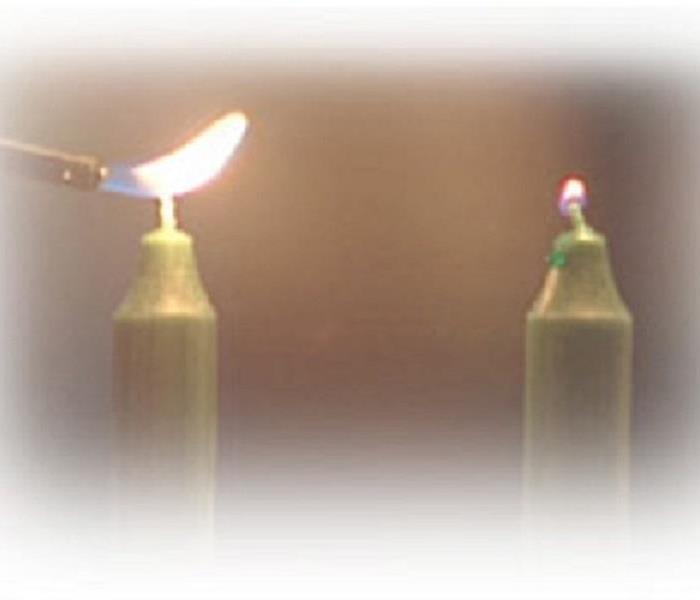Fire Safety & Candles
9/26/2016 (Permalink)
There’s a special beauty and tranquility to candles, but a lighted candle is also an open flame, and a potential fire hazard if not carefully monitored. In fact, accidental candle fires account for approximately four percent of all U.S. residential fires.
A study by the U.S. Consumer Product Safety Commission suggests that 85 percent of candle fires could be avoided if consumers followed three basic safety rules:
- Never leave a burning candle unattended.
- Never burn a candle on or near anything that might catch fire.
- Keep candles out of the reach of children and pets.
The National Candle Association urges consumers to always follow the basic rules of fire safety when burning candles.
What Makes a Safe & Quality Candle?
NCA invites you to view the webinar, What Makes a Safe & Quality Candle?. This webinar is designed to to educate and inform the retail community on candle basics, safety standards, and testing of candle products. This is a must for compliance personnel and candle buyers.
In this webinar, you will learn:
- An Overview of Candle Basics: Wax and wick types, the difference between dyes and pigments, why fragrance does more than just smell nice, and how changing just one of these elements affects the entire candle.
- The ASTM Safety Standards in Plain English: What it means when a flame is too high, what “secondary ignition” and “end of useful life” mean, and the requirements for glass and plastic containers, candle accessories, warning labels and more.
- What to Ask For and Expect from Your Test Lab: What determines if a candle passes or fails the ASTM standards, the common causes of test failures, and what to do if you think you need additional testing.
- Plus: Tips for Success and Q&A
How to Burn a Candle Safely
Before lighting
- Trim the wick to ¼ inch each time before burning. Long or crooked wicks can cause uneven burning, dripping or flaring.
- Always use a candleholder specifically designed for candle use. It should be heat resistant, sturdy, and large enough to contain any drips or melted wax.
- Burn candles in a well-ventilated room.
- Place the candleholder on a stable, heat-resistant surface. This will also help prevent possible heat damage to counters and table surfaces and prevent glass containers from cracking or breaking.
- Keep the wax pool clear of wick trimmings, matches and debris at all times.
- Avoid drafts, vents or air currents. This will help prevent rapid or uneven burning, sooting, and excessive dripping.
- Follow the manufacturer’s recommendations on burn time and proper use.
While burning
- Never touch or move a burning candle. Never move a votive or container candle when the wax is liquefied.
- Don’t burn a candle all the way down. For a margin of safety, discontinue burning a candle when 2 inches of wax remains (1/2 inch if in a container).
- Place burning candles at least three inches apart from one another. This is to make sure they don’t melt one another, or create their own drafts that will cause the candles to burn improperly.
- Extinguish a candle if the flame becomes too high or flickers repeatedly. Let the candle cool, trim the wick, and check for unwanted drafts before re-lighting.
- Always keep the candle within your sight. If you are going to leave the room, be sure to first blow out all candles.
- Always burn candles in a well-ventilated room. Don’t burn too many candles in a small room or in a “tight” home where air exchange is limited.
- Never use a candle as a night light.
- Be very careful if using candles during a power outage. Flashlights and other battery-powered lights are safer sources of light during a power failure. Never use a candle during a power outage to look for things in a closet, or when fueling equipment – such as a lantern or kerosene heater.
- Never burn a candle on or near anything that can catch fire. Keep burning candles away from furniture, drapes, bedding, carpets, books, paper, flammable decorations, etc.
- Keep candles out of the reach of children and pets. Do not place lighted candles where they can be knocked over by children, pets or anyone else.
When extinguishing
- Use a candle snuffer to extinguish a candle. It’s the safest way to prevent hot wax from splattering.
- Never use water to extinguish a candle. Water can cause the hot wax to splatter and might break a glass container.
- Make sure the candle is completely out and the wick ember is no longer glowing before leaving the room.
- Don’t touch or move the candle until it has completely cooled.
- Never use a knife or sharp object to remove wax drippings from a glass holder. It might scratch, weaken, or cause the glass to break upon subsequent use.
Download a complete list of candle safety rules.
Candle Fire Statistics
Nearly 10,000 residential fires are caused each year by the careless or inappropriate use of candles.
The National Candle Association urges consumers to always keep a burning candle within sight, keep candles away from anything combustible, and to keep candles out of the reach of children and pets.
- These bedroom fires caused 32% of deaths associated with candle fires and 47% of associated injuries.
- On average, 25 home candle fires are reported per day.
- Falling asleep was a factor in 11% percent of the home candle fires and 30% of the associated deaths.
- More than half (58%) of home candle fires occurred when some form of combustible material was left or came too close to the candle.
- December is the peak time of year for home candle fires. In December, 11% of home candle fires began with decorations, compared to 4% the rest of the year.





 24/7 Emergency Service
24/7 Emergency Service